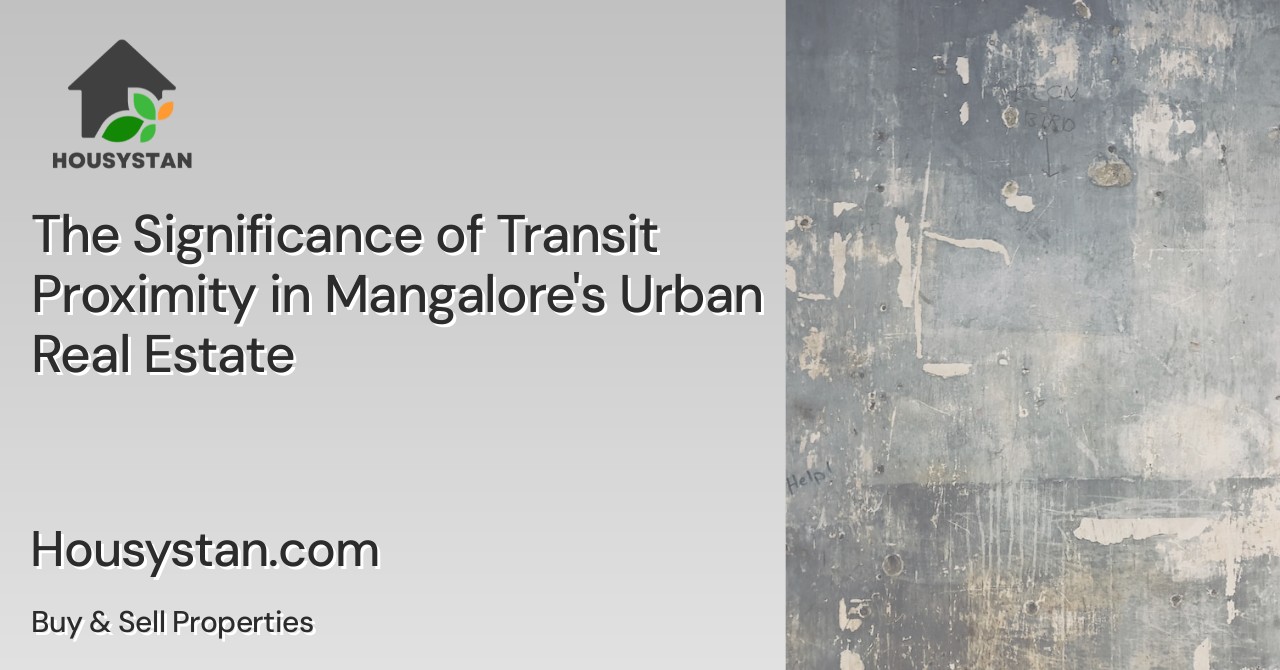The Significance of Transit Proximity in Mangalore's Urban Real Estate
Read latest blogs and articles from Housystan

The Information mentioned here was last updated on:
25/11/2025The Significance of Transit Proximity in Mangalore's Urban Real Estate
Mangalore, a coastal city in India, is known for its vibrant culture, beautiful beaches, and growing economic potential. As the city continues to expand, one key factor is making waves in the urban real estate market: transit proximity. With improved transportation infrastructure, the city's connectivity is becoming a vital aspect for real estate investors and homeowners alike. Let's delve into what makes transit proximity so crucial in Mangalore's real estate scene.
Understanding Transit Proximity
- Verified Tenants/Buyers
- Unlimited Property Listing
- Zero subscription/charges fee
Before we explore its significance, we need to understand what transit proximity means. In simple terms, it refers to the distance and ease of accessing public transportation options such as buses, railways, metro lines, and airports from residential or commercial properties.
- Proximity to transportation hubs can significantly enhance a property's desirability.
- Easy access to such services is increasingly becoming a priority for homebuyers and renters.
The Growing Network of Transportation in Mangalore
Over recent years, Mangalore has seen substantial improvements in its transportation infrastructure. Key developments include:
- Expansion of Bus Services: The city's robust bus network covers an extensive area, providing frequent services to various parts of the city and beyond. [Learn more about Mangalore's public transport system]().
- Development of Rail Links: Mangalore's connectivity to major Indian cities is enhanced via a comprehensive rail network.
- Mangalore International Airport: Located just outside the city, the airport connects Mangalore to both domestic and international destinations, making it a gateway for tourists and business travelers. Check here for more about Mangalore International Airport [Mangalore Airport]().
The Impact of Transit Proximity on Real Estate
Transit proximity influences urban real estate in numerous ways, from increasing property values to dictating development patterns. Here are some key impacts:
- Higher Property Values: Properties near major transit routes often command higher prices due to their convenience and accessibility.
- Real estate value can increase by up to 20% in areas well-served by public transportation.
- Improved Rental Demand: For renters, proximity to transit can be a deal-breaker.
- Properties that are easily accessible via public transport are more likely to attract tenants willing to pay a premium.
- Increased Investment Opportunities: Investors gravitate towards areas with better transit options.
- Developments near transit hubs tend to offer better returns on investment.
- Reduced Transportation Costs: Residents near transit lines save time and money.
- Reduced need for personal vehicles lowers costs associated with parking, fuel, and maintenance.
Real Estate Development Trends in Transit Areas
The presence of transit options influences urban planning and growth patterns. In Mangalore, certain trends emerge:
- Transit-Oriented Developments (TODs): These are mixed-use residential and commercial areas designed to maximize access to public transport.
- Encourages walkability and reduces reliance on cars.
- Focus on Sustainable Housing: As more people look to reduce their carbon footprints, developments near transit lines are incorporating eco-friendly features.
- Developers are investing in energy-efficient buildings and green spaces.
The Role of Government Policies
Government policies play an instrumental role in shaping the relationship between transit and real estate. In Mangalore, supportive policies include:
- Subsidies and Incentives: Governments may offer tax incentives for developments in transit-rich areas.
- Such policies encourage more sustainable urban growth.
- Infrastructure Development Grants: Grants and funding are allocated to improve public transportation, which in turn raises property values.
How Homebuyers Use Transit Proximity as a Deciding Factor
For the average homebuyer or renter, being close to transit directly impacts daily life:
- Convenience: Easier commutes mean more time with family and less time in traffic.
- This convenience is often a major selling point in real estate listings.
- Accessibility: Proximity to transit can make urban amenities, like schools and hospitals, more reachable.
- Enhances quality of life by providing easy access to essential services.
Challenges Associated with Transit Proximity
While there are many benefits, there are also challenges linked to being near transit lines:
- Noise Pollution: Closeness to busy transport lines can come with increased noise levels.
- Noise-reducing construction techniques and materials are often needed.
- Higher Cost of Living: As property values rise, so do living expenses, potentially pushing lower-income residents out of their neighborhoods.
- Balancing development with affordability remains a significant challenge for urban planners.
Final Thoughts
The significance of transit proximity in Mangalore's urban real estate landscape is undeniable. From boosting property values to shaping the future of urban development, accessibility to transportation is at the forefront of decision-making for both developers and residents. As Mangalore continues to grow, transit-oriented developments and sustainable planning will likely remain central to the city's expansion, creating a more connected, efficient, and vibrant urban environment for all.
For more insights on Mangalore's urban housing trends, check here [Mangalore Real Estate Trends]().
Real estate sectors globally are evolving, and Mangalore is no exception. The interplay between transportation and property development highlights the importance of strategic urban planning in creating thriving, sustainable cities.